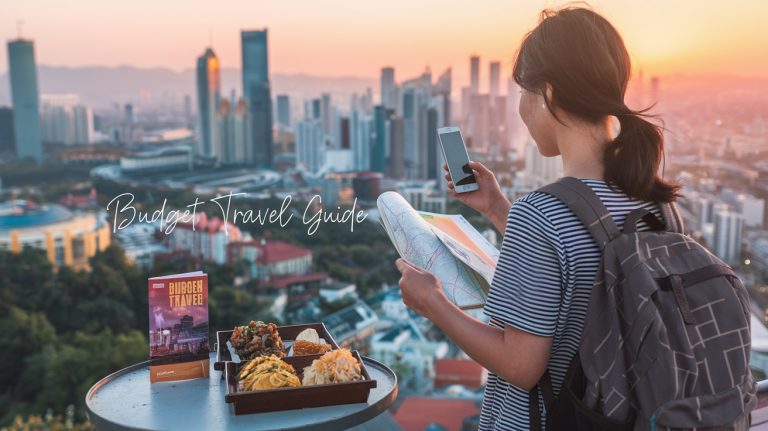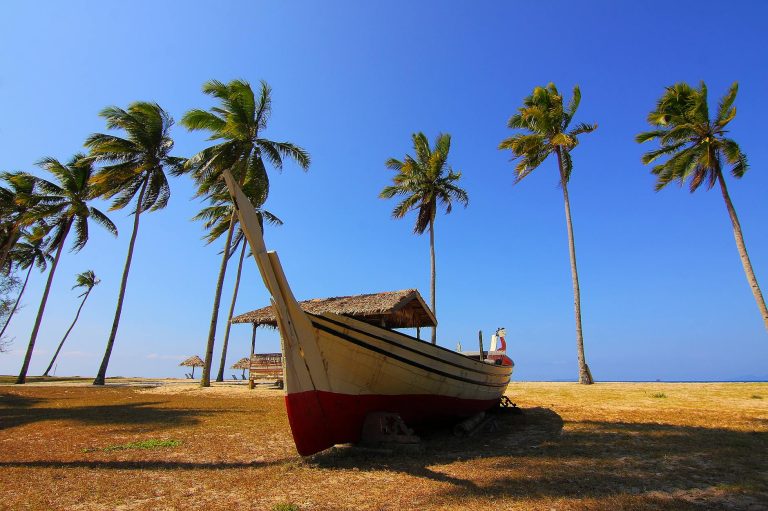8 Travel Mistakes That Make You Look Like a Target

Solo travelers, families, and anyone exploring new destinations need to know how certain travel mistakes can make them easy targets for pickpockets, scammers, and thieves. Simple errors like flashing expensive gear, fumbling with maps in busy areas, or dressing like a stereotypical tourist send clear signals that you’re unfamiliar with your surroundings.
This guide covers the most common blunders that put travelers at risk. You’ll learn how displaying valuable items and poor money handling habits attract unwanted attention from criminals looking for easy marks. We’ll also explore how your clothing choices and navigation struggles can mark you as an outsider, plus the behavioral patterns and technology mistakes that compromise your safety while abroad.
Displaying Expensive Items That Scream Tourist

Wearing flashy jewelry and designer accessories
Expensive jewelry acts like a neon sign advertising your wealth to potential criminals. That diamond watch, gold necklace, or designer earrings might make you feel confident, but they also make you an instant target. Pickpockets and thieves scan crowds specifically looking for people wearing valuable accessories that suggest they carry cash or other expensive items.
Many travelers make the mistake of wearing their best jewelry to feel dressed up while exploring new destinations. This is particularly problematic in areas known for tourist crime. Your grandmother’s pearl necklace or that anniversary bracelet becomes a liability when criminals assume you’re carrying matching valuables in your bag.
The smartest approach involves leaving expensive jewelry at home entirely. If you must wear accessories, choose inexpensive alternatives that complement your outfit without screaming wealth. Costume jewelry, basic watches, and simple accessories allow you to look put-together without broadcasting your financial status to everyone around you.
Using high-end electronics carelessly in public
Pulling out the latest iPhone, expensive camera equipment, or premium headphones in busy tourist areas sends a clear message about your spending power. Criminals often target travelers with high-end electronics because these items are easily resold and valuable enough to make theft worthwhile.
The way you handle these devices matters just as much as owning them. Leaving your expensive camera unattended at a restaurant table, using your laptop in crowded public spaces, or charging your premium phone in visible locations creates opportunities for theft. Many travel mistakes involve being too casual with expensive electronics in unfamiliar environments.
Smart travelers keep expensive electronics discretely stored when not in use. Consider using older devices while traveling or investing in protective cases that don’t advertise the brand. When you must use expensive equipment, stay aware of your surroundings and avoid displaying multiple high-value items simultaneously.
Carrying luxury brand luggage and bags
Designer luggage and handbags create immediate assumptions about your financial status and travel budget. That Louis Vuitton suitcase or Gucci handbag suggests you can afford expensive accommodations, meals, and shopping, making you an attractive target for various scams and theft attempts.
Luxury brand items also signal inexperience with budget travel. Criminals and scam artists often assume people with expensive luggage are less street-smart and more likely to fall for common tourist traps. Your designer bag becomes a billboard advertising that you might be an easy mark for overpricing or elaborate cons.
Choose functional, unremarkable luggage and bags that blend in with local styles. Quality doesn’t require designer labels, and traveling with subtle, durable luggage keeps you safer while still protecting your belongings. Save the luxury items for destinations where displaying wealth won’t compromise your security.
Poor Money Handling Habits That Attract Thieves

Flashing Large Amounts of Cash Openly
Nothing screams “easy target” quite like pulling out a thick wad of bills in public. When you flash cash openly, you’re basically advertising that you’re carrying money worth stealing. Pickpockets and petty criminals watch for these exact moments, especially in tourist-heavy areas where they know visitors often carry more cash than locals.
The simple act of counting money at a restaurant table or pulling out multiple bills while shopping sends a clear signal that you have more where that came from. Smart travelers keep their cash discreet and only pull out what they need for each transaction. If you must count money, do it privately in your hotel room or a bathroom stall, never in plain sight of strangers.
Using ATMs in Unsafe or Isolated Locations
ATM selection can make or break your safety while traveling. Those standalone machines in dark alleys, empty parking lots, or sketchy neighborhoods are practically begging for trouble. Criminals often target these isolated spots because they know you’ll be distracted and vulnerable while conducting your transaction.
Instead, stick to ATMs inside banks, hotels, or busy shopping centers where there’s plenty of foot traffic and security cameras. Bank-operated ATMs also tend to have better fraud protection than independent machines. If you absolutely must use an ATM at night, choose one that’s well-lit and has people around. Trust your gut – if a location feels off, find another option.
Keeping All Money and Cards in One Place
This travel mistake ranks as one of the most devastating because when you lose everything, you really lose everything. Keeping all your cash, credit cards, and debit cards in a single wallet or purse means that one successful pickpocket or mugging leaves you completely stranded.
Smart money management means spreading your resources across multiple locations on your body and in your luggage. Keep some cash in your main wallet, some in a hidden money belt, and a bit more stashed in your hotel room safe. Same goes for cards – carry one credit card and one debit card with you, while keeping backups stored separately. This way, if disaster strikes, you’ll still have backup funds to get by.
Not Securing Payment Methods Properly
Your payment methods need protection beyond just spreading them around. Unsecured cards and cash make you an easy mark for both opportunistic thieves and organized criminals. Leaving your wallet hanging out of your back pocket or your purse unzipped practically invites trouble.
Consider investing in RFID-blocking wallets to prevent electronic pickpocketing of your chip-enabled cards. Keep your main wallet in a front pocket or inside jacket pocket where you can feel if someone tries to grab it. For women, crossbody bags worn in front provide much better security than shoulder bags that swing behind you. Money belts worn under clothing offer excellent protection for backup cash and cards, though they’re not convenient for frequent access.
The key is making your valuables harder to steal than the next person’s, because criminals typically go for the easiest targets available.
Navigation Mistakes That Signal You’re Lost

Standing in crowded areas while studying maps
Nothing screams “easy target” quite like someone hunched over a paper map in the middle of a busy tourist area. Picture this: you’re blocking foot traffic, completely absorbed in deciphering street names while pickpockets size you up like a hawk eyeing prey. That folded map in your hands might as well be a neon sign announcing “tourist with valuables.”
Professional travelers know better. They step into cafes, duck into shop doorways, or find quiet corners before consulting their maps. Your vulnerability skyrockets when you’re stationary and distracted in crowded spaces like train stations, popular plazas, or busy intersections.
Smart navigation means preparation. Study your route before leaving your accommodation. Screenshot key sections of your map onto your phone as backup. If you must check directions while out, move away from the crowd flow and keep your head up between glances at your map.
Looking confused and asking strangers for directions repeatedly
Wandering around with that deer-in-headlights expression tells everyone within a fifty-foot radius that you’re completely out of your element. Asking multiple strangers for the same location within minutes makes you memorable to the wrong people – including those watching for distracted tourists to exploit.
Each time you approach someone for help, you’re revealing exactly where you’re trying to go and how lost you really are. Criminals often work in teams, and that helpful stranger might be communicating your movements to accomplices positioned along your intended route.
Instead of broadcasting your confusion, ask for directions at official locations: hotel front desks, tourist information centers, or shops. These interactions are safer and more reliable than random street encounters. When you do need to ask locals, choose your sources wisely – look for families with children, elderly couples, or business employees rather than individuals loitering in tourist areas.
Using your phone’s GPS obviously in unfamiliar areas
Constantly staring at your phone screen while walking through unfamiliar neighborhoods makes you an ideal target for both theft and accidents. Phone snatchers specifically watch for tourists absorbed in their devices, especially in areas known for grab-and-run tactics.
The dead giveaway isn’t just holding your phone – it’s how you hold it. Tourists typically grip their devices with both hands, stop abruptly to recalibrate their location, and hold the screen at obvious angles that broadcast their dependency on navigation apps.
Professional approach: use audio directions through discreet earbuds, glance at your phone briefly rather than staring continuously, and keep your device close to your body rather than extended outward. Learn to read your route in chunks – check your phone, memorize the next few turns, then put it away and walk confidently to your next checkpoint.
Clothing Choices That Mark You as an Outsider

Wearing clothes that don’t match local customs
Your wardrobe choices can instantly broadcast your tourist status before you even open your mouth. In many countries, locals have subtle dress codes that visitors often miss entirely. For example, wearing shorts and tank tops while exploring temples in Southeast Asia doesn’t just violate religious customs—it also marks you as someone who didn’t bother researching basic cultural norms.
Religious sites across Europe, the Middle East, and Asia require modest clothing. Showing up in revealing attire forces you to either buy overpriced cover-ups at tourist shops or miss out on important cultural experiences. Women traveling in conservative countries who ignore local dress expectations may face unwanted attention or harassment.
Business districts in major cities have their own unwritten rules. Walking through London’s financial district in flip-flops and board shorts makes you stand out like a neon sign. Similarly, overly casual clothing in upscale European neighborhoods can attract pickpockets who assume you’re carrying tourist-level cash.
Research local customs before packing. Check if your destination has specific color associations, religious considerations, or seasonal traditions that affect clothing choices. A quick online search can save you from committing embarrassing cultural mistakes that instantly identify you as an unprepared visitor.
Dressing too casually or formally for the setting
Getting the formality level wrong creates an immediate disconnect between you and locals. Americans often pack their most comfortable athleisure wear for European city breaks, not realizing that locals rarely wear sweatpants or gym clothes outside actual fitness activities. This casual approach makes tourists easy to spot in Paris cafés or Roman piazzas.
On the flip side, some travelers overdress for casual destinations. Wearing business attire to explore beach towns or hiking destinations creates the opposite problem—you look completely out of place and potentially wealthy enough to rob.
Context matters enormously. Beach destinations call for different clothing than mountain towns, which differ from urban centers. Even within the same city, different neighborhoods have varying dress expectations. The clothing appropriate for exploring historic districts might seem overdressed in bohemian arts quarters.
Study photos from your destination on social media to gauge local style. Notice what people wear for different activities and times of day. Pay attention to how locals dress for dining, sightseeing, and evening activities. This research helps you blend in naturally rather than standing out as someone who clearly doesn’t belong.
Choosing impractical footwear for walking
Nothing screams “tourist” quite like limping through cobblestone streets in brand-new sneakers or attempting to climb cathedral steps in flip-flops. Poor footwear choices don’t just mark you as an outsider—they can create safety hazards and limit your mobility.
Many European cities feature uneven cobblestone streets, marble steps, and steep inclines that demand proper footwear. Wearing flimsy sandals or high heels makes navigation difficult and increases your risk of falls or injuries. Locals recognize visitors who struggle with basic walking because they chose style over practicality.
Breaking in new shoes during travel ranks among the most common travel mistakes. Blisters and foot pain slow you down, make you an easy target, and force frequent stops that advertise your discomfort to potential opportunists. Uncomfortable footwear also affects your posture and gait, making you appear vulnerable or distracted.
Weather conditions add another layer of complexity. Wearing canvas shoes during rainy seasons or open-toed sandals in dusty environments shows poor planning. Locals dress appropriately for their climate year-round, so weather-inappropriate footwear immediately identifies visitors.
Test all travel shoes extensively before departure. Break them in completely and ensure they can handle various terrain types you’ll encounter.
Ignoring weather-appropriate clothing options
Seasonal clothing mismatches create obvious tourist markers that locals spot immediately. Visitors often pack based on their home climate expectations rather than researching actual destination weather patterns. This leads to summer clothing in unexpectedly cool mountain regions or heavy winter gear in mild Mediterranean winters.
Many destinations have microclimates that change dramatically within short distances. Coastal areas might require layers for temperature fluctuations, while inland regions maintain more consistent conditions. Ignoring these variations leaves travelers visibly unprepared and uncomfortable.
Seasonal timing affects more than just temperature. Monsoon seasons, dry periods, and regional weather patterns influence local clothing choices throughout the year. Tourists wearing inappropriate seasonal clothing look unprepared and potentially wealthy enough to afford replacing inadequate gear.
Rain preparation varies significantly by region. Some areas experience brief afternoon showers while others have extended rainy seasons. Locals know when to carry umbrellas, wear waterproof layers, or avoid certain fabrics that become problematic when wet.
Check detailed weather forecasts and seasonal patterns before packing. Consider elevation changes in your itinerary, as mountain regions can be significantly cooler than coastal areas. Pack versatile layers that adapt to changing conditions rather than committing to single-climate clothing choices.
Behavioral Patterns That Show Inexperience

Taking Photos of Every Mundane Detail
Constantly snapping pictures of street signs, restaurant menus, taxi meters, and ordinary buildings sends a clear message: you’re not from around here. While capturing memories is part of traveling, photographing every single detail makes you stand out like a sore thumb. Locals don’t take pictures of the corner grocery store or the bus stop they pass daily.
Smart travelers are selective about their photo opportunities. Instead of documenting everything, focus on truly meaningful moments or unique architectural features. When you do take photos, be discreet. Use your phone casually rather than wielding a massive camera with multiple lenses. Consider taking mental notes instead of photos for mundane reference information – you can always look up restaurant hours or directions later.
Speaking Loudly in Your Native Language
Your voice carries more than you realize, especially in quiet public spaces or cultural sites. Speaking loudly in English (or any foreign language) immediately identifies you as a visitor and can make locals uncomfortable. This behavior often comes across as inconsiderate and shows you’re not aware of local social norms.
Volume control varies significantly between cultures. What feels like normal conversation in New York might be considered disruptively loud in Tokyo or Copenhagen. Pay attention to how locals interact in different settings. In museums, temples, and public transportation, keep your voice low and conversations brief. When asking for help or directions, approach people politely and speak at a conversational level that matches the environment.
Acting Overly Trusting with Strangers
Friendliness can be a beautiful thing, but being too trusting too quickly puts you at risk. Experienced travelers have learned to balance openness with healthy skepticism. This doesn’t mean being rude or suspicious of everyone, but rather maintaining appropriate boundaries until you get a better sense of someone’s intentions.
Common red flags include strangers who approach you with unsolicited help, people who seem overly interested in your travel plans or accommodations, and anyone who tries to rush you into decisions. Genuine locals offering assistance usually respect your personal space and don’t pressure you. Take time to assess situations and trust your instincts. If something feels off, politely decline and walk away.
Following Tourist Crowds Blindly
Moving with the pack might feel safe, but it actually makes you more vulnerable to pickpockets and scams who specifically target tourist groups. Large crowds of obvious visitors create perfect cover for thieves and mark everyone in the group as potential targets.
Experienced travelers often explore popular attractions during off-peak hours or find alternative viewpoints that offer similar experiences without the crowds. Research multiple routes to your destinations so you’re not dependent on following others. If you do find yourself in a tourist crowd, stay alert and keep your belongings secure. Don’t assume safety in numbers – that’s exactly what criminals count on.
Not Respecting Local Etiquette and Customs
Every destination has unwritten rules about appropriate behavior, dress, and social interactions. Ignoring these customs doesn’t just mark you as inexperienced – it can also be genuinely offensive to locals and even get you into trouble.
Before traveling, research basic cultural norms like tipping practices, greeting customs, and dress codes for religious sites. Simple gestures like removing shoes when entering homes, covering shoulders in conservative areas, or understanding local dining etiquette show respect and help you blend in. When in doubt, observe what locals do and follow their lead. Most people appreciate when visitors make an effort to understand and respect their culture, even if you don’t get everything perfect.
Poor Situational Awareness That Creates Vulnerability

Walking Alone in Unfamiliar Areas After Dark
Walking alone through unknown neighborhoods after sunset is one of the most common travel mistakes that puts you squarely in criminals’ crosshairs. Criminals actively scout for isolated individuals who appear disoriented or unfamiliar with their surroundings. When you’re wandering alone at night, checking your phone for directions every few steps, you might as well wear a sign that says “easy target.”
Dark streets create natural advantages for potential attackers. Limited visibility makes it harder for you to spot danger approaching, while also providing cover for anyone with ill intentions. Empty sidewalks mean fewer witnesses and less chance of help arriving quickly. Even in cities that feel relatively safe during daylight hours, the dynamics shift dramatically once the sun goes down.
Smart travelers stick to well-lit, busy areas when venturing out at night. If you absolutely need to be somewhere after dark, take a taxi or rideshare service instead of walking. When staying in hotels, ask the front desk staff about safe routes and areas to avoid. They know the local landscape better than any guidebook ever could.
Ignoring Your Surroundings While Distracted
Phone zombies make perfect victims for pickpockets and street criminals. When you’re completely absorbed in your device – whether you’re taking photos, scrolling social media, or trying to navigate – you broadcast your distraction to everyone around you. Criminals watch for these moments of vulnerability and strike when your attention is elsewhere.
The problem goes beyond just phone usage. Travelers often get caught up in the excitement of new sights, sounds, and experiences. While soaking in the atmosphere is part of the joy of travel, losing complete awareness of your environment creates dangerous blind spots. You might miss warning signs like someone following you, aggressive panhandlers approaching, or suspicious activity in your immediate area.
Developing a habit of regular environmental checks keeps you safer. Every few minutes, look up from whatever you’re doing and scan your surroundings. Notice who’s around you, identify potential escape routes, and trust your instincts if something feels off. This doesn’t mean being paranoid – just staying alert enough to spot trouble before it finds you.
Not Researching Safe Versus Unsafe Neighborhoods
Flying blind into a new destination without understanding the local safety landscape is asking for trouble. Every city has neighborhoods where tourists should exercise extra caution or avoid entirely, but these areas aren’t always obvious from a quick map glance. What looks like a charming historic district online might actually have serious crime problems that locals know to avoid.
Crime patterns vary dramatically even within the same city. A perfectly safe area during business hours might transform into a danger zone after offices close. Tourist-heavy districts often have different risk profiles than residential neighborhoods. Without proper research, you could easily book accommodations or plan activities in areas that put you at unnecessary risk.
Before traveling, spend time researching neighborhood safety through multiple sources. Check recent crime statistics, read traveler forums, and look up local news reports. Government travel websites often provide area-specific safety information. Once you arrive, ask hotel staff, tour guides, or other locals about areas to avoid and safe transportation options. This preparation helps you make informed decisions rather than learning about danger zones the hard way.
Technology Usage That Compromises Your Safety

Posting real-time location updates on social media
Broadcasting your exact location while traveling ranks among the most dangerous travel mistakes you can make. When you post that beach selfie with location tags or check into restaurants as you arrive, you’re essentially creating a real-time map of your movements for anyone to follow. Criminals monitor social media specifically for these opportunities, knowing exactly where to find unsuspecting tourists and when they’ll be away from their accommodations.
The problem goes deeper than just revealing where you are right now. Your posts create patterns that savvy criminals can predict. If you’re posting from the hotel pool every morning at 9 AM, thieves know exactly when your room will be empty. Smart travelers either disable location services entirely or post their adventures after they’ve already left each location. Save those Instagram stories for when you’re safely back home or at least moved on to your next destination.
Using unsecured public Wi-Fi for sensitive activities
Public Wi-Fi networks in airports, cafes, and hotels offer convenience but create massive security vulnerabilities. These networks rarely use proper encryption, making your data visible to anyone with basic hacking knowledge sitting nearby. Cybercriminals specifically target tourist hotspots, knowing travelers will desperately connect to any available network to check emails, book accommodations, or access banking information.
The risks multiply when you use these networks for sensitive activities like online banking, entering passwords, or accessing work accounts. Hackers can easily intercept this information and use it long after your trip ends. Your travel mistakes in cybersecurity can haunt you for months or years afterward.
Smart travelers invest in VPN services or use their phone’s hotspot feature instead of public networks. When you absolutely must use public Wi-Fi, stick to browsing general websites and avoid anything requiring passwords or personal information.
Keeping important information unprotected on devices
Storing sensitive travel information directly on your devices without proper protection creates unnecessary risks. Many travelers keep photos of their passports, credit cards, hotel confirmations, and itineraries saved in easily accessible folders on their phones or tablets. When these devices get stolen or compromised, criminals gain access to everything they need to impersonate you or access your accounts.
The lack of device security makes this problem worse. Travelers often disable lock screens for convenience or use simple passwords that anyone can guess. Some even write down device passwords on paper stored in the same bag as their electronics.
Create a secure system for protecting your important travel documents and information:
- Use strong, unique passwords or biometric locks on all devices
- Store sensitive documents in password-protected, encrypted apps
- Keep digital copies in secure cloud storage with two-factor authentication
- Never store complete credit card numbers or passport details in plain text
- Consider using a dedicated travel phone with minimal personal information
Your devices hold the keys to your identity and finances. Treating them with the same care you’d give to physical cash and documents prevents travel mistakes that could ruin your entire trip and create problems long after you return home.
Transportation Choices That Increase Your Risk

Taking Unofficial Taxis or Ride Services
Unofficial taxis and unlicensed ride services represent one of the biggest transportation-related travel mistakes tourists make. These vehicles often look legitimate, with drivers approaching you at airports, train stations, or tourist areas offering rides at seemingly competitive rates. The reality is that many of these operations are unregulated, uninsured, and potentially dangerous.
Unlicensed drivers may overcharge tourists, take unnecessarily long routes to increase fares, or worse, put passengers in compromising situations. Some operate with accomplices who target travelers carrying valuable items or large amounts of cash. The lack of proper insurance means you have no recourse if accidents occur or belongings go missing.
| Official vs. Unofficial Transport Comparison |
|---|
| Official: Regulated rates, licensed drivers, insurance coverage |
| Unofficial: Variable pricing, unknown driver background, no protection |
Not Verifying Legitimate Transportation Options
Before arriving at any destination, research the official transportation methods available. Many cities have specific taxi companies, ride-sharing apps, or public transport systems that are considered safe and reliable. Download official apps, note license plate formats, and understand standard pricing structures.
Airport and hotel concierges can provide reliable transportation recommendations. Many airports have designated taxi ranks with official vehicles, while hotels often partner with reputable transport services. Taking five minutes to verify these options can save you from costly mistakes and potentially dangerous situations.
Traveling During High-Crime Hours Unnecessarily
Timing your transportation choices plays a crucial role in personal safety. Late-night and early-morning hours often see increased criminal activity, particularly in urban areas. Avoid traveling alone during these periods unless absolutely necessary, and choose well-lit, busy routes when possible.
Some areas become particularly risky after dark, including certain public transportation routes, walking paths, and even taxi pickup locations. Plan your activities to minimize late-night travel, or arrange secure transportation in advance when unavoidable.
Ignoring Local Transportation Safety Advice
Locals and travel advisories provide valuable insights about transportation safety that many tourists overlook. Embassy websites, tourist information centers, and hotel staff often share specific warnings about transportation scams or unsafe areas to avoid.
Common advice includes avoiding certain neighborhoods, using specific taxi companies, or steering clear of particular routes during certain times. This local knowledge proves invaluable for making smart transportation decisions that keep you safe while exploring new destinations.

Smart travel comes down to blending in and staying alert. When you flash expensive gear, fumble with large bills, or wander around looking confused with your phone constantly out, you’re basically putting up a neon sign that says “easy target.” The clothes you wear, how you carry yourself, and even which transportation you choose all send signals about whether you’re a seasoned traveler or someone who might be carrying more cash than street smarts.
Your safety abroad doesn’t require paranoia, just common sense. Dress like the locals, keep your valuables hidden, learn basic navigation before you arrive, and always stay aware of what’s happening around you. These simple changes will help you enjoy your trip without constantly looking over your shoulder. Remember, the goal isn’t to live in fear but to travel confidently while making smart choices that keep you off the radar of people with bad intentions.






